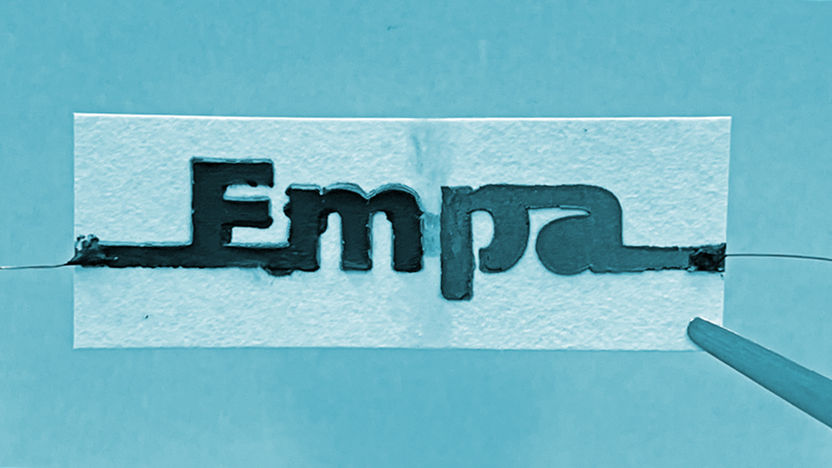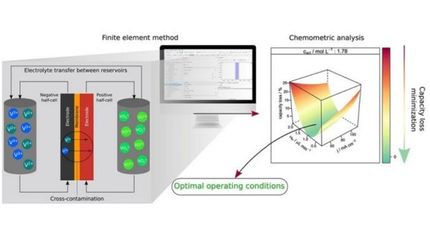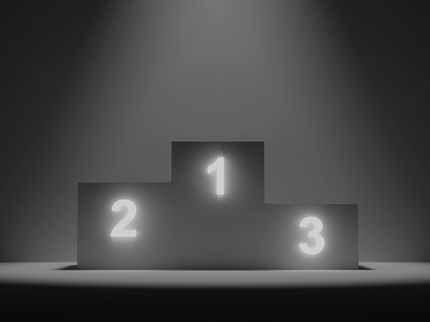Water-activated paper battery among the world's best inventions
Simple idea with complex technology
Every year, TIME publishes a list of the most important inventions of the year. This year, Gustav Nyström and his team from Empa's Cellulose & Wood Materials Laboratory made it onto the list with their biodegradable disposable battery, which points the way to the future of environmentally friendly electronics.

The paper battery is composed of two electrochemical cells – at both ends of the paper strip – separated by a water barrier (between the letters "m" and "p") and connected in series.
Empa
TIME listed the Empa team amongst the winners in the category "Experimental" – one of more than 20 areas in which the most important inventions of the year are identified and honored, from artificial intelligence to new apps and electronics to fitness, nutrition and entertainment. To choose the best ideas in each category, the jury evaluates the inventions according to originality, creativity, efficiency, impact and other criteria.
In addition to the invention from the Empa lab, this year the magazine awarded, among others, life-mapping artificial intelligence, diamonds made from excess carbon in the air, and the most powerful telescope ever. Just how creative the human inventive spirit is, is also shown by the fact that this year, for the first time, not 100 but 200 inventions from all over the world were honored.
Simple idea with complex technology
The battery, devised by Gustav Nyström and his team, is made of at least one cell measuring one centimeter squared and consisting of three inks printed onto a rectangular strip of paper. Salt, in this case simply sodium chloride or table salt, is dispersed throughout the strip of paper and one of its shorter ends has been dipped in wax. An ink containing graphite flakes, which acts as the positive end of the battery (the cathode), is printed onto one of the flat sides of the paper while an ink containing zinc powder, which acts as the negative end of the battery (the anode), is printed onto the reverse side of the paper.
Yet another ink containing graphite flakes and carbon black is printed on both sides of the paper, on top of the other two inks. This ink makes up the current collectors connecting the positive and negative ends of the battery to two wires, which are located at the wax-dipped end of the paper.
Water as a trigger
The result of this "construction method": When a small amount of water is added, the salts within the paper dissolve and charged ions are released, thus making the electrolyte ionically conductive. These ions activate the battery by dispersing through the paper, resulting in zinc in the ink at the anode being oxidized thereby releasing electrons. By closing the (external) circuit these electrons can then be transferred from the zinc-containing anode – via the graphite- and carbon black-containing ink, the wires and the device – to the graphite cathode where they are transferred to – and hence reduce – oxygen from ambient air. These redox reactions (reduction and oxidation) thus generate an electrical current that can be used to power an external electrical device.
Proof of Concept with an alarm clock
To demonstrate the ability of their battery to run low-power electronics, Nyström's team combined two cells into one battery to increase the operating voltage and used it to power an alarm clock with a liquid crystal display. Analysis of the performance of a one-cell battery revealed that after two drops of water were added, the battery activated within 20 seconds and, when not connected to an energy-consuming device, reached a stable voltage of 1.2 volts. The voltage of a standard AA alkaline battery is 1.5 volts.
After one hour, the one-cell battery’s performance decreased significantly due to the paper drying. However, after the researchers added two extra drops of water, the battery maintained a stable operating voltage of 0.5 volts for more than one additional hour.
What's special about the new battery: By making both paper and zinc and the other components biodegradable, this could significantly minimize the environmental impact of disposable, low-power electronics. A significant step towards green electronics!
On the TIME list for the second time
This year's award from TIME is not the first invention from Empa's laboratories to make it onto the illustrious list; back in 2009, another Empa development – also from the Cellulose & Wood Materials Laboratory – was voted among the (then) 50 best inventions of the year: the biotech violin by Francis Schwarze and his team.
Original publication
Other news from the department science
Most read news
More news from our other portals
See the theme worlds for related content
Topic World Battery Technology
The topic world Battery Technology combines relevant knowledge in a unique way. Here you will find everything about suppliers and their products, webinars, white papers, catalogs and brochures.

Topic World Battery Technology
The topic world Battery Technology combines relevant knowledge in a unique way. Here you will find everything about suppliers and their products, webinars, white papers, catalogs and brochures.




























































